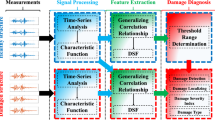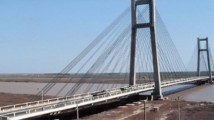Abstract
The motivation for this article is to propose new damage classifiers based on a supervised learning problem for locating and quantifying damage. A new feature extraction approach using time series analysis is introduced to extract damage-sensitive features from auto-regressive models. This approach sets out to improve current feature extraction techniques in the context of time series modeling. The coefficients and residuals of the AR model obtained from the proposed approach are selected as the main features and are applied to the proposed supervised learning classifiers that are categorized as coefficient-based and residual-based classifiers. These classifiers compute the relative errors in the extracted features between the undamaged and damaged states. Eventually, the abilities of the proposed methods to localize and quantify single and multiple damage scenarios are verified by applying experimental data for a laboratory frame and a four-story steel structure. Comparative analyses are performed to validate the superiority of the proposed methods over some existing techniques. Results show that the proposed classifiers, with the aid of extracted features from the proposed feature extraction approach, are able to locate and quantify damage; however, the residual-based classifiers yield better results than the coefficient-based classifiers. Moreover, these methods are superior to some classical techniques.
Similar content being viewed by others
References
Abasi A, Harsij V and Soraghi A (2021), “Damage Detection of 3D Structures Using Nearest Neighbor Search Method,” Earthquake Engineering and Engineering Vibration, 20(3): 705–725.
Amezquita-Sanchez JP and Adeli H (2016), “Signal Processing Techniques for Vibration-Based Health Monitoring of Smart Structures,” Archives of Computational Methods in Engineering, 23(1): 1–15.
Avci O, Abdeljaber O, Kiranyaz S, Hussein M, Gabbouj M and Inman DJ (2021), “A Review of Vibration-Based Damage Detection in Civil Structures: From Traditional Methods to Machine Learning and Deep Learning applications,” Mechanical Systems and Signal Processing, 147: 107077.
Ay AM and Wang Y (2014), “Structural Damage Identification Based on Self-Fitting ARMAX Model and Multi-Sensor Data Fusion,” Structural Health Monitoring, 13(4): 445–460.
Bisgaard S and Kulahci M (2011), Time Series Analysis and Forecasting by Example, John Wiley & Sons, Hoboken, New Jersey, United States.
Box GE, Jenkins GM, Reinsel GC and Ljung GM (2015), Time Series Analysis: Forecasting and Control, John Wiley & Sons, Hoboken, New Jersey, United States.
Daneshvar MH, Gharighoran A, Zareei SA and Karamodin A (2021), “Early Damage Detection Under Massive Data via Innovative Hybrid Methods: Application to a Large-Scale Cable-Stayed Bridge,” Structure and Infrastructure Engineering, 17(7): 902–920.
de Lautour OR and Omenzetter P (2010), “Nearest Neighbor and Learning Vector Quantization Classification for Damage Detection Using Time Series Analysis,” Structural Control and Health Monitoring, 17(6): 614–631.
Diez A, Khoa NLD, Alamdari MM, Wang Y, Chen F and Runcie P (2016), “A Clustering Approach for Structural Health Monitoring on Bridges,” Journal of Civil Structural Health Monitoring, 6(3): 429–445.
Ding Y, Yao X, Wang S and Zhao X (2019), “Structural Damage Assessment Using Improved Dempster-Shafer Data Fusion Algorithm,” Earthquake Engineering and Engineering Vibration, 18(2): 395–408.
Dyke SJ, Bernal D, Beck J and Ventura C (2003), “Experimental Phase II of the Structural Health Monitoring Benchmark Problem,” Proceedings of the 16th ASCE Engineering Mechanics Conference, Seattle, WA, 16–18 July, 2003, USA.
Entezami A, Sarmadi H, Behkamal B and Mariani S (2020a), “Big Data Analytics and Structural Health Monitoring: A Statistical Pattern Recognition-Based Approach,” Sensors, 20(8): 2328.
Entezami A, Sarmadi H and Saeedi Razavi B (2020b), “An Innovative Hybrid Strategy for Structural Health Monitoring by Modal Flexibility and Clustering Methods,” Journal of Civil Structural Health Monitoring, 10(3): 845–859.
Entezami A, Sarmadi H, Salar M, De Michele C and Nadir Arslan A (2021), “A Novel Data-Driven Method for Structural Health Monitoring Under Ambient Vibration and High Dimensional Features by Robust Multidimensional Scaling,” Structural Health Monitoring, doi: https://doi.org/10.1177/1475921720973953.
Entezami A and Shariatmadar H (2018), “An Unsupervised Learning Approach by Novel Damage Indices in Structural Health Monitoring for Damage Localization and Quantification,” Structural Health Monitoring, 17(2): 325–345.
Entezami A and Shariatmadar H (2019), “Damage Localization Under Ambient Excitations and Non-Stationary Vibration Signals by a New Hybrid Algorithm for Feature Extraction and Multivariate Distance Correlation Methods,” Structural Health Monitoring, 18(2): 347–375.
Entezami A, Shariatmadar H and Karamodin A (2019), “Data-Driven Damage Diagnosis Under Environmental and Operational Variability by Novel Statistical Pattern Recognition Methods,” Structural Health Monitoring, 18(5–6): 1416–1443.
Entezami A, Shariatmadar H and Mariani S (2020c), “Early Damage Assessment in Large-Scale Structures by Innovative Statistical Pattern Recognition Methods Based on Time Series Modeling and Novelty Detection,” Advances in Engineering Software, 150: 102923.
Entezami A, Shariatmadar H and Sarmadi H (2017), “Structural Damage Detection by a New Iterative Regularization Method and an Improved Sensitivity Function,” Journal of Sound and Vibration, 399: 285–307.
Farrar CR, Doebling SW and Nix DA (2001), “Vibration-Based Structural Damage Identification,” Philosophical Transactions of the Royal Society A: Mathematical, Physical and Engineering Sciences, 259: 131–149.
Farrar CR and Worden K (2007), “An Introduction to Structural Health Monitoring,” Philosophical Transactions of the Royal Society A: Mathematical, Physical and Engineering Sciences, 365(1851): 303–315.
Fassois SD and Sakellariou JS (2009), “Statistical Time Series Methods for Structural Health Monitoring,” Encyclopedia of Structural Health Monitoring, John Wiley & Sons, Ltd, 443–472.
Figueiredo E, Park G, Figueiras J, Farrar C and Worden K (2009), “Structural Halth Monitoring Algorithm Comparisons Using Standard Data Sets,” No. LA-14393, Los Alamos National Lab (LANL), Los Alamos, NM, USA.
Gharehbaghi VR, Nguyen A, Noroozinejad Farsangi E and Yang TY (2020), “Supervised Damage and Deterioration Detection in Building Structures Using an Enhanced Autoregressive Time-Series Approach,” Journal of Building Engineering, 30: 101292.
Goyal D and Pabla B (2016), “The Vibration Monitoring Methods and Signal Processing Techniques for Structural Health Monitoring: a Review,” Archives of Computational Methods in Engineering, 23(4): 585–594.
Hsu TY, Shih YC and Pham QV (2019), “Damage Detection of a Thin Plate Using Modal Curvature via Macrostrain Measurement,” Earthquake Engineering and Engineering Vibration, 18(2): 409–424.
Kankanamge Y, Hu Y and Shao X (2020), “Application of Wavelet Transform in Structural Health Monitoring,” Earthquake Engineering and Engineering Vibration, 19(2): 515–532.
Langone R, Reynders E, Mehrkanoon S and Suykens JA (2017), “Automated Structural Health Monitoring Based on Adaptive Kernel Spectral Clustering,” Mechanical Systems and Signal Processing, 90: 64–78.
Leybourne SJ and McCabe BP (1994), “A Consistent Test for a Unit Root,” Journal of Business & Economic Statistics, 12(2): 157–166.
Li HN, Ren L, Jia ZG, Yi TH and Li DS (2016), “State-of-the-Art in Structural Health Monitoring of Large and Complex Civil Infrastructures,” Journal of Civil Structural Health Monitoring, 6(1): 3–16.
Li S, Pan J, Luo G and Wang J (2020), “Automatic Modal Parameter Identification of High Arch Dams: Feasibility Verification,” Earthquake Engineering and Engineering Vibration, 19(4): 953–965.
Mei L, Mita A and Zhou J (2016), “An Improved Substructural Damage Detection Approach of Shear Structure Based on ARMAX Model Residual,” Structural Control and Health Monitoring, 23: 218–236.
Montgomery DC, Jennings CL and Kulahci M (2015), Introduction to Time Series Analysis and Forecasting, John Wiley & Sons, Hoboken, New Jersey, United States.
Mosavi AA, Dickey D, Seracino R and Rizkalla S (2012), “Identifying Damage Locations Under Ambient Vibrations Utilizing Vector Autoregressive Models and Mahalanobis Distances,” Mechanical Systems and Signal Processing, 26: 254–267.
Palanci M (2019), “Fuzzy Rule Based Seismic Risk Assessment of One-Story Precast Industrial Buildings,” Earthquake Engineering and Engineering Vibration, 18(3): 631–648.
Prabakaran K, Kumar A and Thakkar SK (2015), “Comparison of Eigensensitivity and ANN Based Methods in Model Updating of an Eight-Story Building,” Earthquake Engineering and Engineering Vibration, 14(3): 453–464.
Rezaiee-Pajand M, Entezami A and Sarmadi H (2020), “A Sensitivity-Based Finite Element Model Updating Based on Unconstrained Optimization Problem and Regularized Solution Methods,” Structural Control and Health Monitoring, 27(5): e2481.
Rezaiee-Pajand M, Entezami A and Shariatmadar H (2017), “An Iterative Order Determination Method for Time-Series Modeling in Structural Health Monitoring,” Advances in Structural Engineering, 21(2): 300–314.
Rezaiee-Pajand M, Sarmadi H and Entezami A (2021), “A Hybrid Sensitivity Function and Lanczos Bidiagonalization-Tikhonov Method for Structural Model Updating: Application to a Full-Scale Bridge Structure,” Applied Mathematical Modelling, 89: 860–884.
Roy K, Bhattacharya B and Ray-Chaudhuri S (2015), “ARX Model-Based Damage Sensitive Features for Structural Damage Localization Using Output-Only Measurements,” Journal of Sound and Vibration, 349: 99–122.
Santos A, Figueiredo E and Costa J (2015), “Clustering Studies for Damage Detection in Bridges: A Comparison Study,” Structural Health Monitoring, 2015.
Sarmadi H (2021), “Investigation of Machine Learning Methods for Structural Safety Assessment under Variability in Data: Comparative Studies and New Approaches,” Journal of Performance of Constructed Facilities, 35(6): 04021090.
Sarmadi H and Entezami A (2021), “Application of Supervised Learning to Validation of Damage Detection,” Archive of Applied Mechanics, 91(1): 393–410.
Sarmadi H, Entezami A and Daneshvar Khorram M (2020a), “Energy-Based Damage Localization Under Ambient Vibration and Non-Stationary Signals by Ensemble Empirical Mode Decomposition and Mahalanobis-Squared Distance,” Journal of Vibration and Control, 26(11–12): 1012–1027.
Sarmadi H, Entezami A and Ghalehnovi M (2020b), “On Model-Based Damage Detection by an Enhanced Sensitivity Function of Modal Flexibility and LSMR-Tikhonov Method Under Incomplete Noisy Modal Data,” Engineering with Computers. https://doi.org/10.1007/s00366-020-01041-8
Sarmadi H, Entezami A, Saeedi Razavi B and Yuen KV (2021a), “Ensemble Learning-Based Structural Health Monitoring by Mahalanobis Distance Metrics,” Structural Control and Health Monitoring, 28(2): e2663.
Sarmadi H, Entezami A, Salar M and De Michele C (2021b), “Bridge Health Monitoring in Environmental Variability by New Clustering and Threshold Estimation Methods,” Journal of Civil Structural Health Monitoring, 11(3): 629–644.
Sarmadi H and Karamodin A (2020), “A Novel Anomaly Detection Method Based on Adaptive Mahalanobis-Squared Distance and One-Class kNN Rule for Structural Health Monitoring Under Environmental Effects,” Mechanical Systems and Signal Processing, 140:106495.
Sarmadi H, Karamodin A and Entezami A (2016), “A New Iterative Model Updating Technique Based on Least Squares Minimal Residual Method Using Measured Modal Data,” Applied Mathematical Modelling, 40(23): 10323–10341.
Sarmadi H and Yuen KV (2021), “Early Damage Detection by an Innovative Unsupervised Learning Method Based on Kernel Null Space and Peak-over-Threshold,” Computer-Aided Civil and Infrastructure Engineering, 36(9): 1150–1167.
Sen D, Aghazadeh A, Mousavi A, Nagarajaiah S, Baraniuk R and Dabak A (2019), “Data-Driven Semi-Supervised and Supervised Learning Algorithms for Health Monitoring of Pipes,” Mechanical Systems and Signal Processing, 131: 524–537.
Sohn H, Czarnecki JA and Farrar CR (2000), “Structural Health Monitoring Using Statistical Process Control,” Journal of Structural Engineering, 126(11): 1356–1363.
Su TL, Tang ZY, Peng LY, Bai YT, Jin XB and Kong JL (2020), “Model Updating for Real Time Dynamic Substructures Based on UKF Algorithm,” Earthquake Engineering and Engineering Vibration, 19(2): 413–421.
Tang T, Yang DH, Wang L, Zhang JR and Yi TH (2019), “Design and Application of Structural Health Monitoring System in Long-Span Cable-Membrane Structure,” Earthquake Engineering and Engineering Vibration, 18(2): 461–474.
Worden K and Manson G (2007), “The Application of Machine Learning to Structural Health Monitoring,” Philosophical Transactions of the Royal Society of London A: Mathematical, Physical and Engineering Sciences, 365(1851): 515–537.
Xia Z, Li A, Shi H and Li J (2021), “Model Updating of a Bridge Structure Using Vibration Test Data Based on GMPSO and BPNN: Case Study,” Earthquake Engineering and Engineering Vibration, 20(1): 213–221.
Yu Q, Wang C, McKenna F, Yu SX, Taciroglu E, Cetiner B and Law KH (2020), “Rapid Visual Screening of Soft-Story Buildings from Street View Images Using Deep Learning Classification,” Earthquake Engineering and Engineering Vibration, 19(4): 827–838.
Zhang J, Xu YL, Li J, Xia Y and Li JC (2013), “Statistical Moment-Based Structural Damage Detection Method in Time Domain,” Earthquake Engineering and Engineering Vibration, 12(1): 13–23.
Zhang Q (2007), “Statistical Damage Identification for Bridges Using Ambient Vibration Data,” Computers & Structures, 85(7): 476–485.
Acknowledgement
The authors would like to express their sincere gratitude to the IASC-ASCE Structural Health Monitoring Task Group and the Engineering Institute at the Los Alamos National Laboratory for being able to access their experimental datasets.
Author information
Authors and Affiliations
Corresponding author
Rights and permissions
About this article
Cite this article
Chegeni, M.H., Sharbatdar, M.K., Mahjoub, R. et al. New supervised learning classifiers for structural damage diagnosis using time series features from a new feature extraction technique. Earthq. Eng. Eng. Vib. 21, 169–191 (2022). https://doi.org/10.1007/s11803-022-2079-2
Received:
Accepted:
Published:
Issue Date:
DOI: https://doi.org/10.1007/s11803-022-2079-2




